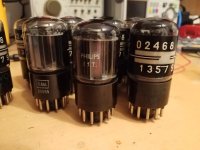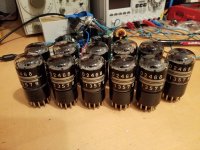Anyone here interested in some E1T tubes?
The E1T is a remarkable tube. In the first place it is a miniature cathode ray tube with a Pierce electron gun, two deflection plates and a fluorescent screen. When the voltage on the deflection plates is varied, the electron beam scans over the fluorescent screen lighting one of the green windows next to the numbers. But it is more than just an indicator device such as a nixie or numitron tube. The E1T is not only an indicator, it is also a counter! Without the need for external active components it can count pulses at a rate up to 40 kHz, while counting rates up to 1 MHz have been demonstrated under laboratory conditions. So in modern day language the tube contains a memory of 3.5 bits. The memory is realized in a very clever way. The Philips Researchers placed a screen with slotted apertures in the path of the electron beam just in front of the fluorescent screen. When the beam passes a slot, one of the numbers is illuminated, though only very little current flows though the aperture. However, when the beam hits the screen in between two slots, the full bundle current is now carried by the screen. With a simple feedback circuit this current is used to adjust the voltage on the deflection plates so that the beam stays “locked” in one of the slot positions. By applying a short AC pulse of well defined amplitude to one of the deflection plates, the beam is forced to the next stable position. All in all a very clever construction, but not an easy one to manufacture.
The E1T is a remarkable tube. In the first place it is a miniature cathode ray tube with a Pierce electron gun, two deflection plates and a fluorescent screen. When the voltage on the deflection plates is varied, the electron beam scans over the fluorescent screen lighting one of the green windows next to the numbers. But it is more than just an indicator device such as a nixie or numitron tube. The E1T is not only an indicator, it is also a counter! Without the need for external active components it can count pulses at a rate up to 40 kHz, while counting rates up to 1 MHz have been demonstrated under laboratory conditions. So in modern day language the tube contains a memory of 3.5 bits. The memory is realized in a very clever way. The Philips Researchers placed a screen with slotted apertures in the path of the electron beam just in front of the fluorescent screen. When the beam passes a slot, one of the numbers is illuminated, though only very little current flows though the aperture. However, when the beam hits the screen in between two slots, the full bundle current is now carried by the screen. With a simple feedback circuit this current is used to adjust the voltage on the deflection plates so that the beam stays “locked” in one of the slot positions. By applying a short AC pulse of well defined amplitude to one of the deflection plates, the beam is forced to the next stable position. All in all a very clever construction, but not an easy one to manufacture.
Attachments
Last edited:
I couldn't find it in my tube book, so I did a little research and came up with this:
https://www.dos4ever.com/E1T/E1T.html
https://www.dos4ever.com/E1T_clock/E1T.html
Hugo
https://www.dos4ever.com/E1T/E1T.html
https://www.dos4ever.com/E1T_clock/E1T.html
Hugo

